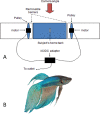Environmental concentrations of metformin exposure affect aggressive behavior in the Siamese fighting fish, Betta splendens
- PMID: 29763426
- PMCID: PMC5953473
- DOI: 10.1371/journal.pone.0197259
Environmental concentrations of metformin exposure affect aggressive behavior in the Siamese fighting fish, Betta splendens
Abstract
Metformin, the medicine most commonly prescribed for treatment of Type II diabetes, is among the most abundant pharmaceuticals being introduced into the environment. Pharmaceuticals are increasingly found in wastewater and surface waters around the world, often due to incomplete metabolism in humans and subsequent excretion in human waste. Risk analyses and exposure studies have raised concerns about potential negative impacts of pharmaceuticals at current environmental levels. Results of the present study indicate that metformin at concentrations in the range of what has been documented in freshwater systems and waste-water effluent (40 μg/L) affects aggressive behavior in adult male Betta splendens. Subjects exhibited less aggression toward a male dummy stimulus after four weeks exposure to metformin-treated water when compared to behavior measured immediately prior to their exposure, and in comparison to a separate cohort of un-exposed control fish. This effect persisted after 20 weeks exposure as well. Subjects exposed to metformin at a concentration twice that currently observed in nature (80 μg/L) exhibited an even more substantial reduction in aggressive behaviors compared to controls and pre-exposure measurements than those observed in the low-dose treatment group. Such changes in behavior have the potential to affect male fitness and possibly impact the health of natural populations of aquatic organisms exposed to the drug.
Conflict of interest statement
Figures




References
-
- Blair BD, Crago JP, Hedman CJ, Klaper RD. Pharmaceuticals and personal care products found in the Great Lakes above concentrations of environmental concern. Chemosphere 2013a; 93: 2116–2123. - PubMed
-
- Boyd GR, Reemtsma H, Grimm DA, Mitra S. Pharmaceuticals and personal care products (PPCPs) in surface and treated waters of Louisiana, USA and Ontario, Canada. Sci. Total Environ. 2003; 311: 135–149. doi: 10.1016/S0048-9697(03)00138-4 - DOI - PubMed
-
- Oosterhuis M, Sacher F, Ter Laak TL. Prediction of concentration levels of metformin and other high consumption pharmaceuticals in wastewater and regional surface water based on sales data. Sci. Total Environ. 2013; 442: 380–388. doi: 10.1016/j.scitotenv.2012.10.046 - DOI - PubMed
-
- Fatta-Kassinos D, Meric S, Nikolaou A. Pharmaceutical residues in environmental waters and wastewater: Current state of knowledge and future research. Anal. Bioanal. Chem. 2011; 399: 251–275. doi: 10.1007/s00216-010-4300-9 - DOI - PubMed
-
- Heberer T. Occurrence, fate, and removal of pharmaceutical residues in the aquatic environment: A review of recent research data. Toxicol. Lett. 2002; 131: 5–17. - PubMed
Publication types
MeSH terms
Substances
LinkOut - more resources
Full Text Sources
Other Literature Sources
Molecular Biology Databases

